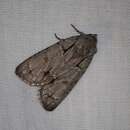Conservation Status
provided by University of Alberta Museums
Rare, at the extreme western edge of it's range in southeastern Alberta.
- license
- cc-by-nc
- copyright
- University of Alberta Museums
Cyclicity
provided by University of Alberta Museums
A worn adult was collected in Alberta in mid August.
- license
- cc-by-nc
- copyright
- University of Alberta Museums
Distribution
provided by University of Alberta Museums
Across southern Canada south of the Boreal forest, from New Brunswick west to eastern Alberta, south to GA, NE, and AR. In Alberta it has been collected only once to date (2001), in riparian shrub along the South Saskatchewan River near the Saskatchewan border, south of Empress. An eastern species that barely reaches Alberta in the dry southeastern part of the province.
- license
- cc-by-nc
- copyright
- University of Alberta Museums
General Description
provided by University of Alberta Museums
A medium-size (3.5-4.2 cm wingspan) pale grey moth. The forewings have a prominent black basal dash, which forks upward and downward at the antemedian line, and a thin, prominent black streak through a dark patch ("dagger-mark") in the anal angle. The cross-lines, with the exception of the postmedian line, are incomplete and indicated mainly by black marks where they meet the costa. The orbicular is a prominent pale spot narrowly outlined in dark scales. The reniform is vestigial, and consists of a dark marking the proximal side. The postmedian line is complete, s-shaped, doubled, and filled with white scales. The fringe is checkered, with the dark scales between the veins. The hindwing is dirty white in the male, darkening near the outer margin and along the outer veins, and light grey with a faint postmedian band in the female. Antennae in both sexes simple.
- license
- cc-by-nc
- copyright
- University of Alberta Museums
Habitat
provided by University of Alberta Museums
Dry deciduous woodland edge and tall shrub.
- license
- cc-by-nc
- copyright
- University of Alberta Museums
Life Cycle
provided by University of Alberta Museums
A solitary defoliator of deciduous trees and shrubs. There is a single annual brood that overwinters in the pupal stage. Adults come to light.
- license
- cc-by-nc
- copyright
- University of Alberta Museums
Trophic Strategy
provided by University of Alberta Museums
A variety of deciduous trees and shrubs. No Alberta data, but elsewhere in Canada White elm (Ulmus americana) appears to be the main larval host, with the occasional record of pin cherry (Prunus pennsylvanicus), Ironwood (Ostrya virginiana), Mountain ash (Sorbus sp.), White and Yellow birch (Betula papyrifera and B. lutea), and willow (Salix sp.). Other hosts include apple (Malus sp.), oak (Quercus) and hawthorn (Craetagus).
- license
- cc-by-nc
- copyright
- University of Alberta Museums
Acronicta interrupta
provided by wikipedia EN
Acronicta interrupta, the interrupted dagger moth, is a moth of the family Noctuidae. The species was first described by Achille Guenée in 1852. It is found across southern Canada south of the boreal forest, from New Brunswick west to eastern Alberta, south to Georgia, Nebraska and Arizona.[1][2]
The wingspan is 35–42 mm. Adults are on wing from April to August or September depending on the location. There are two or more generations per year in the south and one in the north.
The larvae feed on apple, apricot, birch, cherry, crabapple, elm, hawthorn, hop-hornbeam, mountain-ash, oak, plum and willow.
References
-
^ Beccaloni, G.; Scoble, M.; Kitching, I.; Simonsen, T.; Robinson, G.; Pitkin, B.; Hine, A.; Lyal, C., eds. (2003). "Acronicta interrupta". The Global Lepidoptera Names Index. Natural History Museum. Retrieved October 20, 2020.
-
^ Savela, Markku (August 29, 2020). "Acronicta interrupta (Guenée, 1852)". Lepidoptera and Some Other Life Forms. Retrieved October 20, 2020.

- license
- cc-by-sa-3.0
- copyright
- Wikipedia authors and editors
Acronicta interrupta: Brief Summary
provided by wikipedia EN
Acronicta interrupta, the interrupted dagger moth, is a moth of the family Noctuidae. The species was first described by Achille Guenée in 1852. It is found across southern Canada south of the boreal forest, from New Brunswick west to eastern Alberta, south to Georgia, Nebraska and Arizona.
The wingspan is 35–42 mm. Adults are on wing from April to August or September depending on the location. There are two or more generations per year in the south and one in the north.
The larvae feed on apple, apricot, birch, cherry, crabapple, elm, hawthorn, hop-hornbeam, mountain-ash, oak, plum and willow.
- license
- cc-by-sa-3.0
- copyright
- Wikipedia authors and editors

